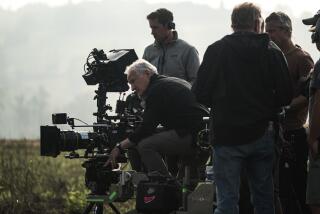No Need for Him to Rent : Marvin Eisenman used to manage a grocery store, but severe back and knee injuries disabled him. So he started collecting. Now he has nearly 25,000 films, videos and laser discs.
Almost everyone who makes regular trips to the video store occasionally has a hard time finding something worth watching, especially on weekends, when everything new or good has already been rented.
But Marvin Eisenman never faces that problem. Thatâs because he has a personal collection of films, videos and laser discs numbering nearly 25,000--thought to be among the largest in the country, perhaps the world.
After becoming disabled with severe knee and back problems in 1979, Eisenman says he and his late first wife were âvegetatingâ until they discovered the joys of movies on tape--and he has been taping and collecting ever since.
The tapes, discs and films have their own rooms, but they overflow his Encino house. Eisenman, 67, estimates that he has spent well over $150,000 in his passion for film--money earned through the real estate investments he made after he was no longer physically able to work at his job as a grocery store manager.
He knows that itâs at least a little bizarre to devote so much of his life to movies. Yet, like most collectors, Eisenman canât really articulate why he spends countless dollars and hours on this hobby; itâs just an obsession he feeds.
âBut Iâm not putting stuff up my nose or drinking,â he protests. âItâs an addiction, but Iâm helping preserve a medium.â
Indeed, he has become a source to whom writers, movie stars and producers often turn when in search of rare or obscure films--including Jack Haley Jr. (producer of âThatâs Dancingâ and all three âThatâs Entertainmentâ films) and Leonard Maltin (âEntertainment Tonightâsâ film critic and historian).
Maltin recalls once speaking with William Conrad, who was eager to see an old film--âI Met Him in Parisâ with Claudette Colbert--because âhe told me he had patterned his life after the Melvyn Douglas character.â But the 1937 film had not been released to home video. âIf I tried through channels, I would have hit roadblocks, dead ends and legal hurdles,â Maltin says, so he called Eisenman, who had the film and made a tape for Conrad to watch.
âHe was so thrilled and so moved I cannot begin to tell you,â Maltin says of the late actor.
Eisenmanâs collection does contain a large number of recent and current films that can be found in any video store (âI just have to have everything that was ever madeâ), but he gets the most pleasure out of hunting down and obtaining copies of films that arenât commercially available, from âJust Imagineâ with El Brendel to âThe Magic Bowâ with Stewart Granger. He even has several Alice Faye pictures (âKing of Burlesque,â âWake Up and Live,â âSally, Irene and Maryâ) that were never released.
Eisenman and like-minded friends sometimes pool money and efforts to find such âlostâ films.
Of the 15 episodes of âThe Lone Rangerâ serial, for instance, Chapters 10 and 15 were considered lost. In 1987, through calls, letters and faxes, Eisenman and his friends tracked down the missing pair in France, with French dialogue. They obtained copies of the original scripts, rented time at a studio and dubbed them back into English with their own amateur voices.
Gregory Lukow, administrative director of the National Center for Film and Video Preservation at the American Film Institute, recognizes the value of collectors to the film medium. âThere are still some âlostâ films out there,â Lukow says, and he is hopeful that prints of films such as âRogue Songâ with Laurel and Hardy, or âLondon After Midnight,â with Lon Chaney Sr., may surface among collectors.
Not everyone takes an entirely positive view of these aggressive collectors, however, because not all of them find their movies through legitimate means. Tony Adamski, director of U.S. anti-piracy operations for the Motion Picture Assn. of America, says he is more interested in stopping âmass-volume major distributorsâ of pirated films and videos but does keep an eye on collectors: âWhere thereâs a violation of the law, weâll go after them.â
Eisenman says everything in his collection was obtained legally. And while he has had to pay quite a bit for certain films, he doesnât sell what he has--he only trades or gives away copies in exchange for a credit in a book or on a film. âA true collector is willing to share; otherwise, heâs a hog,â he explains.
On Eisenmanâs âmost wantedâ list of the films he has not yet tracked down are âThe Gift of Gab,â âThe Best Man Winsâ and the 1929 version of âThe Spoilers,â all of which have somehow eluded him.
But Eisenmanâs greatest passion is movie serials from the sound era, low-budget films the studios churned out, typically with 12 to 15 episodes each. Of the 231 serials, including âDick Tracyâ and âFlash Gordon,â Eisenman has complete collections of more than 200; most recently he acquired all 15 chapters of the 1942 serial âCaptain Midnight.â
When he isnât busy collecting films, heâs busy watching them. A 70-by-70-inch projection television is the home theater where he sometimes screens eight to 10 pictures a day. âIf I would not have gotten into my hobby,â he says, âI would have been dead. You have to have a goal in life. I have too many things to do to die.â
Born the day âThe Jazz Singerâ premiered, Eisenmanâs infatuation with the big screen dates to his childhood, when he spent weekends watching many of those serials. That gives him an idea of why he and so many others seek out films from that era later in life.
âRecapturing our youth, thatâs why we want to find old movies.â He adds wistfully: âOften, the films are good, but not quite as good as we remembered.â*
More to Read
The biggest entertainment stories
Get our big stories about Hollywood, film, television, music, arts, culture and more right in your inbox as soon as they publish.
You may occasionally receive promotional content from the Los Angeles Times.










